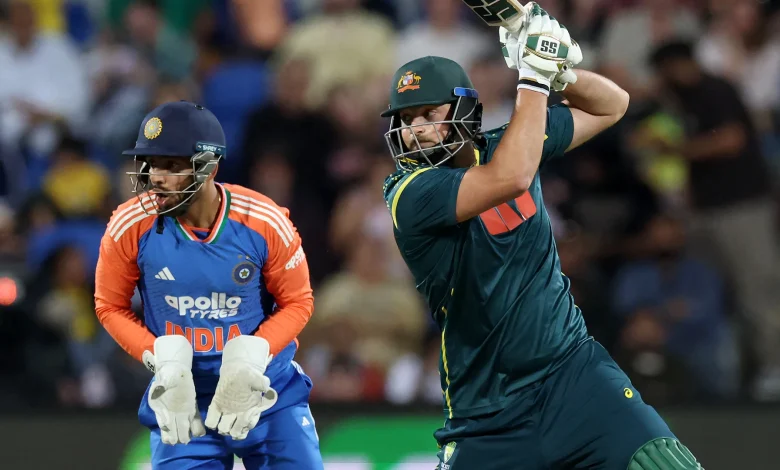Finisher to starter: Tim David’s extraordinary T20I leap

David unleashes 129m monster, gets Aussies going with rapid 74
At the Manuka Oval practice wickets earlier this week, a group of teenagers walking by Tim David’s net session on an adjoining footpath stopped to watch him. Perhaps lured by the crack off his bat, the schoolkids then started cheering his every blow.
At Bellerive Oval on Sunday, India’s T20 side, unlike those kids, had seen David bat before. He played three seasons with their T20 captain, Suryakumar Yadav at Mumbai Indians in the Indian Premier League. Still, his mix of conventional and modern stroke-play, and particularly his off-side hitting, appeared to briefly flummox even the laidback Suryakumar.
It is now up to Australia’s T20 brains trust to manage their own reaction to David’s extraordinary batting. With a World Cup looming in a format that they are appearing one of the standout teams for, Andrew McDonald and co. are grappling with the question of how they deploy the game’s hottest short-form talent.
His latest outburst, a rollicking 38-ball 74 that sent sixes to all parts of his home Big Bash ground, came in a defeat with India levelling the BKT Tyres series after overhauling Australia’s 6-186 with nine balls to spare. The result to one side, it was further vindication for Australia’s decision to push David, whose T20I strike-rate (199.47) among batters with at least 150 runs this year is bettered only by Abhishek Sharma’s (200.85), up their batting order.
Before July, David had never batted in the Powerplay for Australia.
When he was brought into their side as a lower-order finisher in 2022 on the back of their maiden T20 World Cup win the previous year, he filled a hole the Aussies had been attempting to plug for years. Despite him finding a home in a reliable middle-order alongside Glenn Maxwell, Marcus Stoinis and Matthew Wade, Australia flopped at the next two editions of the ICC event. It has prompted a recent rethink of their batting approach.
Going harder while the fielding restrictions are in place has been one key part of the shift. Getting David into the game earlier has been a major factor in their swift transition to the new style and, given his lack of experience facing the new ball, his Powerplay returns have been remarkable.
Against India in Hobart, David came to the crease in the third over with just 14 runs on the board. He drove his first ball for four with a traditional off drive off Arshdeep Singh, before blitzing Jasprit Bumrah and Varun Chakaravarthy for boundaries as he bludgeoned his way to 26 from 14 balls by the time the fielding restrictions were lifted. It proved a sound launchpad to keep attacking.
It had been a similar story in games earlier this year. Against West Indies in July, he started his innings in the third and fifth T20Is in the Powerplay, going on to cart 102no off just 37 balls and 30 off 12 respectively. He was in during the fourth over during the first two T20Is against South Africa the following month, making 83 off 52 and 50 off 24.
There has been no more effective Powerplay batter this year in T20Is. From 45 balls faced with the field up, David has hit 97 runs and been out just once. His Powerplay strike-rate is 215.56, the best of anyone who has scored at least 60 runs.
In short, Australia’s best batter at the end of their innings has also become one of their best players at the start of it.
“In the Powerplay, any ball you hit that goes past the field, you get a boundary,” David told reporters on Sunday.
“You don’t have to hit over the fielders, so it can be a little bit easier. But at the same time I’m batting at the stage where the ball doesn’t swing as much. The openers are taking that challenge on.
“But it’s good fun. I like trying to put pressure back on the opposition. I think that’s really important, because you’ve seen how the scores are going up (as is) the skill level of the batting. We’ve got to keep powering on. We got high 180s today and it wasn’t enough.
“It’s a new challenge for me, having not done it so much, but I’m getting experience up the order now and trying to make the most of those different challenges that I’m getting.”
Australia will hope by the time they head to the subcontinent after this summer’s Ashes, Cameron Green and Glenn Maxwell will also both be back in their first-choice T20 side.
Green, who has prioritised preparing for the Ashes over playing the white-ball matches against India to begin the home summer, has batted at the No.4 position David is currently occupying in all but three of his most recent 12 T20Is. One of those came at three when David batted right behind him at four.
Green is in fact the only man who rivals David’s recent early-overs dominance among middle-order options in the Australian side. His current Powerplay strike-rate is only marginally lower (214.71), having pumped 73 from the 34 balls in T20Is this year.
David relishing ‘new challenge’ up the order in T20 format
“I’m not going to pick the team, but the coach has given me a challenge to face more balls and have a bigger impact on the match. I’ve been really enjoying that,” said David.
“We’re just trying to figure out different combinations and get guys experience in different positions. So I’ll bat wherever I need to.
“We can change the batting order at any time. Trust the coaches with what they’re trying to build in this team. I think it’s about what how we communicate together as batters.
“The batting order – it’s great to face more balls if I need to, if I need to do a different job, then that’s what I’ll do. We’ve obviously got great players coming back into the squad. If they do, that’s always a positive to have more – we’ve got good firepower in this batting order.”
Maxwell is a different style of player to both Green and David, but Australia’s trial of him opening with Mitch Marsh in the Caribbean earlier this year when Travis Head was absent underscored the faith selectors have in his ability to counter new-ball spin. That could be a viable tactic on turning wickets on the subcontinent.
“It’s hard to predict what the pitches are going to be like in the World Cup, where I think we’re split between Sri Lanka and India,” said David.
“Sometimes maybe the Indian team change the pitch depending on who they’re playing, so it’d be tough to predict, but hopefully we get good batting surfaces like that (Hobart), that’d be good fun.”
Australia v India | Third T20I
Back to the nets in Canberra. What those schoolkids had missed was how David had started his practice hit. For several minutes, he faced gentle throwdowns and hardly hit a ball in the air.
If he was wearing whites, he could have been warming up for a Test match innings. “I hope so,” David said when asked if he enjoys showing the more traditional elements of his batting approach. “That’s up to other people to decide. But I practice with my batting as much as any other batter, and that’s my job.”
It was a glimpse of the sound technique that underpins David’s power game. Mark Waugh, the former ODI opener who made 18 centuries in that format, alluded to it in a roundabout way, telling Fox Cricket: “He’s wasted the first half of his career batting at number seven.”
The back-handed compliment essentially sums up a growing awareness that David is more than a lower-order blaster. Another star former white-ball opener, Aaron Finch, has spoken of how T20 hitters must have the basics of batting down-pat.
“You see guys in T20 now who get really hot for a period and then really cold for a long period,” Finch told Cricket Monthly in an interview earlier this year. “It’s just the fact that they don’t have a fundamental technique to fall back on, and generally they’re younger guys who are still trying to work out their game.”
David is yet to turn 30 but has clearly worked out his game. Whether everyone else has is a different story.
Australia v India T20Is 2025
October 29: No result
October 31: Australia won by four wickets
November 2: India won by five wickets
November 6: Fourth T20I v India, Gold Coast Stadium, Gold Coast, 7:15pm AEDT
November 8: Fifth T20I v India, The Gabba, Brisbane, 7:15pm AEDT
Australia squad: Mitchell Marsh (c), Sean Abbott (games 1-3), Xavier Bartlett, Mahli Beardman (games 3-5), Tim David, Ben Dwarshuis (games 4-5), Nathan Ellis, Josh Hazlewood (games 1-2), Ben McDermott (standby player) Glenn Maxwell (games 3-5), Travis Head, Josh Inglis (wk), Matthew Kuhnemann, Mitchell Owen, Josh Philippe (wk), Matthew Short, Marcus Stoinis, Tanveer Sangha
India squad: Suryakumar Yadav (c), Shubman Gill (vc), Abhishek Sharma, Tilak Varma, Nitish Kumar Reddy, Shivam Dube, Axar Patel, Jitesh Sharma (wk), Varun Chakaravarthy, Jasprit Bumrah, Arshdeep Singh, Kuldeep Yadav, Harshit Rana, Sanju Samson (wk), Rinku Singh, Washington Sundar





